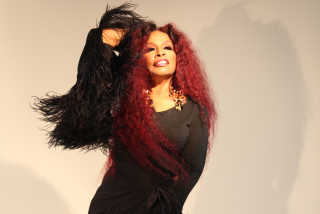ART / CATHY CURTIS : ‘Spiked Tongues’ at Saddleback Punctures Cultural Stereotypes : The hourlong sampler of seven videos attempts, with some success, to sort out confusion on racial identity and allied topics. It shows through Dec. 20.
Did you know that there are more extraterrestrials on broadcast TV than Asians, Latinos and American Indians combined? So says “What’s Wrong With This Picture?,” a 1990 study conducted by Women in Film and the National Commission on Working Women.
Few people would argue that what we see in films and on TV tends to reinforce cultural stereotypes rather than challenging them. From their crude beginnings in the ‘60s, art videos were conceived as a means of using the visual advantages and outreach opportunities of TV in a subversive way, to tell stories and present points of view ignored by mainstream programming.
“Spiked Tongues” is an hourlong sampler of seven recent videos, organized by Michelle Hirshhorn, assistant director of the Los Angeles Center for Photographic Studies, and showing through Dec. 20 at the Saddleback College Art Gallery. With various degrees of success, the seven media artists attempt to articulate our confusions about racial identity and allied topics. It’s not surprising that the better pieces show us rather than telling us, and the best pieces assemble chunks of real life and factual material in such a way that we can draw any number of conclusions.
“All Orientals Look the Same,” by Valerie Soe is very simple, indeed. It lasts just 1 1/2 minutes. The soundtrack consists of a man constantly repeating his assertion that “all Orientals look the same” while the faces of young Asian men and women flash briefly over the screen. A woman’s voice recites the actual national or regional identity of each person: Chinese, Japanese, Korean, Thai, Tongan, Burmese, Indonesian, Cantonese, Malaysian, Taiwanese, Micronesian . . . There is something extremely appealing about this matter-of-fact debunking of ignorance born of laziness and closed-mindedness.
More complex in its message but equally suited to its medium, “Do Y’All Know How to Play ‘Dixie?’ ” by Susana Aikin, Lisa Guido and Carlos Aparicio, shows us a homey scene of people making music in somebody’s kitchen. There’s also a woman fiddler, a big guy in a blue cap on guitar and a male banjo player who wears a Ku Klux Klan outfit. A woman standing near the refrigerator and listening also wears a Klan suit. The serious-faced young boy next to her (her son?) usually can be seen in the background, as the camera moves around the room. Toward the end of the brief video, he breaks into a sheepish but nimble-footed jig.
Superimposed on the bottom of the images is a continuous streamer of text, like news update bulletins on TV. Each tidbit bears the name of a city in the United States and information about a specific Klan activity: firing shots into a black housing project, threatening a black shop owner, planning to bomb NAACP headquarters, and so forth. The news reports span the period 1980 to 1990.
There is a strange disjunction between these news briefs and the images of the people in a kitchen. I found myself looking at the face of the man in the Klan suit, trying to find signs of evil framed by the flaps of his silly pointed cap. But it was just a face, a pale face with a long, skinny nose. If you saw a picture of this man without his suit, just sitting around twiddling his banjo strings, you’d probably think he was a pretty typical middle-aged guy with a knack for bluegrass.
So maybe the point is that you might bump into these people in the supermarket--when they all were wearing their normal clothes--and not realize what horrible ideas they had, or what repugnant actions they had participated in. Maybe the issue is that even evil people are basically normal (as the historian Hannah Arendt put it in her famous phrase, “the banality of evil”).
Perhaps we’re meant to read something sinister into this group’s choice of music. (“Dixie” has long been associated with the kind of retrograde Southern pride that celebrates a strictly white heritage.) We might wonder what the boy is thinking about the activities of his parents and their friends. Is he dying to break away or wondering when he’ll be able to terrorize his first black person? Or maybe he already has.
The brilliance of this work is the way it shows us people whose beliefs are utterly repugnant to us--but in a context in which they seem to be harmlessly going about their business, just having a good time. The makers of this video aren’t telling us what conclusions we ought to reach. They are just suggesting we begin putting two and two together.
An autobiographical chronicle of 31 years of enduring racist remarks and worse, “12 Years,” consists entirely of Joseph Santarromana’s calm, year-by-year narration, a faint but continuous babble of epithets and the unwavering image of his face. He eventually mentions that he is of Filipino heritage, but we learn that many people--including parents of friends or girlfriends--have called him by a racial epithet used for blacks.
Santarromana’s self-proclaimed “positive attitude” and temporizing remarks (“People are complex”) are rather hard to believe. (How can he not feel rage and hostility toward these people, toward everyone who refuses to grant him his real identity?) But the continuous stream of ugly episodes so flatly described in such an unemotional tone of voice has the chilling power of truth.
Other videos in the sampler include Portia Cobb’s “Who Are You?”--an erratically edited piece about the real-life folklore of an unnerving apparition on the streets of Oakland (a black woman who wore white makeup on her face, and a blond wig)--and “Frederick Douglass Now,” by Ben Caldwell, Wesley Michael Groves and Roger G. Smith. A tape of a rap performer (Smith) wishfully calling for the return of the 19th-Century black spokesman and activist is enhanced with predictable film clips contrasting blacks in entertainment and sports fields with scenes of poverty and violence.
Somewhat out of left field, Lawrence Andrews’ “An I for an I” offers a rambling, occasionally hazy commentary about the excess of violence in our lives. Andrews’ strongest artistic weapon is the numbing effect of repetition. In one vivid image, a fist repeatedly socks a bare stomach while a voice keeps urging, “Again. Harder.”
The most disappointing video is “Portrayals of Native American Women in Film: Beyond the Squaw and the Princess,” by Esther Belin. Despite the rich material available (all those raven-haired young Indian women who serve as the doomed or disposable love interests of white cowboys in Hollywood Westerns, from “Broken Arrow” to “Little Big Man”), Belin devotes a good chunk of her video to “talking heads” whose remarks tend to be generalized and repetitious, and whose titles and affiliations (most are professors of American Indian or ethnic studies) are revealed only at the very end.
A more stimulating and visually involving strategy would have been to let the experts compare specific moments in a fuller range of films--from utterly egregious Indian portrayals to comparatively sensitive ones--and to make use of documentary materials about the lives (romantic and otherwise) of real Indian women in the 19th Century.
Despite the mixed quality of the videos in “Spiked Tongues,” however, their honest voices and diverse messages are certainly worth an hour of anybody’s time.
“Spiked Tongues,” a video program, runs through Dec. 20 at Saddleback College Art Gallery, 28000 Marguerite Parkway, Mission Viejo. Gallery hours: 12:30 to 5 p.m. Tuesdays, 9 a.m. to 12:30 p.m. Wednesdays, 12:30 to 5 p.m. and 6 to 8 p.m. Thursdays and 12:30 to 4 p.m. Fridays. Closed weekends. Admission is free. (714) 582-4924.
More to Read
The biggest entertainment stories
Get our big stories about Hollywood, film, television, music, arts, culture and more right in your inbox as soon as they publish.
You may occasionally receive promotional content from the Los Angeles Times.






